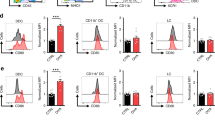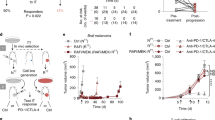Abstract
Expression of CD200, the gene encoding the ligand for the inhibitory immune receptor CD200R, is an independent prognostic factor for various forms of leukemia predicting worse overall survival of the patients. The enhanced expression of CD200 on the tumors implies that anti-tumor responses can be enhanced by blockage of the CD200–CD200R interaction. Indeed, antibody-mediated blockade of the CD200-CD200R inhibitory axis is currently evaluated in clinical tests to boost immune responses against CD200-expressing tumors. Here, we show that mice lacking CD200, the exclusive ligand for CD200R, are resistant to chemical skin carcinogenesis. Importantly, CD200R controls tumor outgrowth independently of CD200 expression by the tumor cells themselves. Furthermore, Cd200−/− mice do not become tolerant to intranasally administered antigens, suggesting that tumor rejection is normally suppressed through CD200-induced immune tolerance. Decreased tumor outgrowth is accompanied by increased expression of the proinflammatory cytokines interleukin (IL)-1β and IL-6 by the lymph node (LN) dendritic cells. During carcinogenesis, skin-draining LNs of Cd200−/− mice contain increased numbers of IL-17-producing FoxP3+ cells, which preferentially home to the tumors. Thus, the CD200-CD200R axis induces tolerance to external and tumor antigens and influences the T-regulatory/Th17 cell ratio. We demonstrate for the first time that the absence of CD200R signaling inhibits outgrowth of an endogenous tumor irrespective of CD200 expression by the tumor cells. This important paradigm shift leads to a much broader applicability of CD200-blockade in the treatment of tumors.
This is a preview of subscription content, access via your institution
Access options
Subscribe to this journal
Receive 50 print issues and online access
$259.00 per year
only $5.18 per issue
Buy this article
- Purchase on Springer Link
- Instant access to full article PDF
Prices may be subject to local taxes which are calculated during checkout





Similar content being viewed by others
References
Baban B, Chandler PR, Sharma MD, Pihkala J, Koni PA, Munn DH et al. (2009). IDO activates regulatory T cells and blocks their conversion into Th17-like T cells. J Immunol 183: 2475–2483.
Brahmer JR, Drake CG, Wollner I, Powderly JD, Picus J, Sharfman WH et al. (2010). Phase I study of single-agent anti-programmed death-1 (MDX-1106) in refractory solid tumors: safety, clinical activity, pharmacodynamics, and immunologic correlates. J Clin Oncol 28: 3167–3175.
Chung Y, Chang SH, Martinez GJ, Yang XO, Nurieva R, Kang HS et al. (2009). Critical regulation of early Th17 cell differentiation by interleukin-1 signaling. Immunity 30: 576–587.
Fallarino F, Asselin-Paturel C, Vacca C, Bianchi R, Gizzi S, Fioretti MC et al. (2004). Murine plasmacytoid dendritic cells initiate the immunosuppressive pathway of tryptophan catabolism in response to CD200 receptor engagement. J Immunol 173: 3748–3754.
Finch JS, Albino HE, Bowden GT . (1996). Quantitation of early clonal expansion of two mutant 61st codon c-Ha-ras alleles in DMBA/TPA treated mouse skin by nested PCR/RFLP. Carcinogenesis 17: 2551–2557.
Fouser LA, Wright JF, Dunussi-Joannopoulos K, Collins M . (2008). Th17 cytokines and their emerging roles in inflammation and autoimmunity. Immunol Rev 226: 87–102.
Gorczynski RM, Cattral MS, Chen Z, Hu J, Lei J, Min WP et al. (1999). An immunoadhesin incorporating the molecule OX-2 is a potent immunosuppressant that prolongs allo- and xenograft survival. J Immunol 163: 1654–1660.
Hoek RM, Ruuls SR, Murphy CA, Wright GJ, Goddard R, Zurawski SM et al. (2000). Down-regulation of the macrophage lineage through interaction with OX2 (CD200). Science 290: 1768–1771.
Koenen HJ, Smeets RL, Vink PM, van RE, Boots AM, Joosten I . (2008). Human CD25highFoxp3pos regulatory T cells differentiate into IL-17-producing cells. Blood 112: 2340–2352.
Kretz-Rommel A, Qin F, Dakappagari N, Ravey EP, McWhirter J, Oltean D et al. (2007). CD200 expression on tumor cells suppresses antitumor immunity: new approaches to cancer immunotherapy. J Immunol 178: 5595–5605.
Kryczek I, Wei S, Szeliga W, Vatan L, Zou W . (2009). Endogenous IL-17 contributes to reduced tumor growth and metastasis. Blood 114: 357–359.
Malliri A, van der Kammen RA, Clark K, van der Valk M, Michiels F, Collard JG . (2002). Mice deficient in the Rac activator Tiam1 are resistant to Ras-induced skin tumours. Nature 417: 867–871.
Maniati E, Soper R, Hagemann T . (2010). Up for mischief? IL-17/Th17 in the tumour microenvironment. Oncogene 29: 5653–5662.
Martin-Orozco N, Muranski P, Chung Y, Yang XO, Yamazaki T, Lu S et al. (2009). T helper 17 cells promote cytotoxic T cell activation in tumor immunity. Immunity 31: 787–798.
McWhirter JR, Kretz-Rommel A, Saven A, Maruyama T, Potter KN, Mockridge CI et al. (2006). Antibodies selected from combinatorial libraries block a tumor antigen that plays a key role in immunomodulation. Proc Natl Acad Sci USA 103: 1041–1046.
Meyer KC, Klatte JE, Dinh HV, Harries MJ, Reithmayer K, Meyer W et al. (2008). Evidence that the bulge region is a site of relative immune privilege in human hair follicles. Br J Dermatol 159: 1077–1085.
Min WP, Zhou D, Ichim TE, Strejan GH, Xia X, Yang J et al. (2003). Inhibitory feedback loop between tolerogenic dendritic cells and regulatory T cells in transplant tolerance. J Immunol 170: 1304–1312.
Molenaar R, Greuter M, van der Marel AP, Roozendaal R, Martin SF, Edele F et al. (2009). Lymph node stromal cells support dendritic cell-induced gut-homing of T cells. J Immunol 183: 6395–6402.
Moreaux J, Hose D, Reme T, Jourdan E, Hundemer M, Legouffe E et al. (2006). CD200 is a new prognostic factor in multiple myeloma. Blood 108: 4194–4197.
Mukhopadhyay S, Pluddemann A, Hoe JC, Williams KJ, Varin A, Makepeace K et al. (2010). Immune inhibitory ligand CD200 induction by TLRs and NLRs limits macrophage activation to protect the host from meningococcal septicemia. Cell Host Microbe 8: 236–247.
Murphy KM, Stockinger B . (2010). Effector T cell plasticity: flexibility in the face of changing circumstances. Nat Immunol 11: 674–680.
Pallasch CP, Ulbrich S, Brinker R, Hallek M, Uger RA, Wendtner CM . (2009). Disruption of T cell suppression in chronic lymphocytic leukemia by CD200 blockade. Leuk Res 33: 460–464.
Petermann KB, Rozenberg GI, Zedek D, Groben P, McKinnon K, Buehler C et al. (2007). CD200 is induced by ERK and is a potential therapeutic target in melanoma. J Clin Invest 117: 3922–3929.
Quintanilla M, Brown K, Ramsden M, Balmain A . (1986). Carcinogen-specific mutation and amplification of Ha-ras during mouse skin carcinogenesis. Nature 322: 78–80.
Ralph C, Elkord E, Burt DJ, O'Dwyer JF, Austin EB, Stern PL et al. (2010). Modulation of lymphocyte regulation for cancer therapy: a phase II trial of tremelimumab in advanced gastric and esophageal adenocarcinoma. Clin Cancer Res 16: 1662–1672.
Rijkers ESK, De Ruiter T, Baridi A, Veninga H, Hoek RM, Meyaard L . (2008). The inhibitory CD200R is differentially expressed on human and mouse T and B lymphocytes. Mol Immunol 45: 1126–1135.
Rosenblum MD, Olasz EB, Yancey KB, Woodliff JE, Lazarova Z, Gerber KA et al. (2004). Expression of CD200 on epithelial cells of the murine hair follicle: a role in tissue-specific immune tolerance? J Investig Dermatol 123: 880–887.
Sharma MD, Hou DY, Baban B, Koni PA, He Y, Chandler PR et al. (2010). Reprogrammed Foxp3(+) regulatory T cells provide essential help to support cross-presentation and CD8(+) T cell priming in naive mice. Immunity 33: 942–954.
Sharma MD, Hou DY, Liu Y, Koni PA, Metz R, Chandler P et al. (2009). Indoleamine 2,3-dioxygenase controls conversion of Foxp3+ Tregs to TH17-like cells in tumor-draining lymph nodes. Blood 113: 6102–6111.
Siva A, Xin H, Qin F, Oltean D, Bowdish KS, Kretz-Rommel A . (2008). Immune modulation by melanoma and ovarian tumor cells through expression of the immunosuppressive molecule CD200. Cancer Immunol Immunother 57: 987–996.
Snelgrove RJ, Goulding J, Didierlaurent AM, Lyonga D, Vekaria S, Edwards L et al. (2008). A critical function for CD200 in lung immune homeostasis and the severity of influenza infection. Nat Immunol 9: 1074–1083.
Taylor N, McConachie K, Calder C, Dawson R, Dick A, Sedgwick JD et al. (2005). Enhanced tolerance to autoimmune uveitis in CD200-deficient mice correlates with a pronounced Th2 switch in response to antigen challenge. J Immunol 174: 143–154.
Tonks A, Hills R, White P, Rosie B, Mills KI, Burnett AK et al. (2007). CD200 as a prognostic factor in acute myeloid leukaemia. Leukemia 21: 566–568.
Tsitoura DC, DeKruyff RH, Lamb JR, Umetsu DT . (1999). Intranasal exposure to protein antigen induces immunological tolerance mediated by functionally disabled CD4+ T cells. J Immunol 163: 2592–2600.
Unger WW, Hauet-Broere F, Jansen W, van Berkel LA, Kraal G, Samsom JN . (2003a). Early events in peripheral regulatory T cell induction via the nasal mucosa. J Immunol 171: 4592–4603.
Unger WW, Jansen W, Wolvers DA, van Halteren AG, Kraal G, Samsom JN . (2003b). Nasal tolerance induces antigen-specific CD4+. Int Immunol 15: 731–739.
van der Marel AP, Samsom JN, Greuter M, van Berkel LA, O'Toole T, Kraal G et al. (2007). Blockade of IDO inhibits nasal tolerance induction. J Immunol 179: 894–900.
Wang L, Yi T, Zhang W, Pardoll DM, Yu H . (2010). IL-17 enhances tumor development in carcinogen-induced skin cancer. Cancer Res 70: 10112–10120.
Wilke CM, Kryczek I, Wei S, Zhao E, Wu K, Wang G et al. (2011). Th17 cells in cancer: help or hindrance? Carcinogenesis 32: 643–649.
Wolvers DA, van der Cammen MJ, Kraal G . (1997). Mucosal tolerance is associated with, but independent of, up-regulation Th2 responses. Immunology 92: 328–333.
Wong KK, Khatri I, Shaha S, Spaner DE, Gorczynski RM . (2010). The role of CD200 in immunity to B cell lymphoma. J Leukoc Biol 88: 361–372.
Wright GJ, Jones M, Puklavec MJ, Brown MH, Barclay AN . (2001). The unusual distribution of the neuronal/lymphoid cell surface CD200 (OX2) glycoprotein is conserved in humans. Immunology 102: 173–179.
Xu L, Kitani A, Fuss I, Strober W . (2007). Cutting edge: regulatory T cells induce CD4+CD25-Foxp3- T cells or are self-induced to become Th17 cells in the absence of exogenous TGF-beta. J Immunol 178: 6725–6729.
Zhou L, Lopes JE, Chong MM, Ivanov II, Min R, Victora GD et al. (2008). TGF-beta-induced Foxp3 inhibits T(H)17 cell differentiation by antagonizing RORgammat function. Nature 453: 236–240.
Acknowledgements
We thank Gerrit Spierenburg for cell sorting, Serge van de Pavert for assistance with the confocal microscope and Lewis Lanier, Frank Miedema, Berent Prakken and Erik Hack for critical review of versions of this manuscript. This research was supported by the Association for International Cancer Research (AICR 07-0086) to LM and TPR and by a VICI grant (918.56.612) (from the Netherlands Organization for Scientific Research) to REM, MJG and RM.
Author information
Authors and Affiliations
Corresponding author
Ethics declarations
Competing interests
The authors declare no conflict of interest.
Additional information
Supplementary Information accompanies the paper on the Oncogene website
Supplementary information
Rights and permissions
About this article
Cite this article
Rygiel, T., Karnam, G., Goverse, G. et al. CD200-CD200R signaling suppresses anti-tumor responses independently of CD200 expression on the tumor. Oncogene 31, 2979–2988 (2012). https://doi.org/10.1038/onc.2011.477
Received:
Revised:
Accepted:
Published:
Issue Date:
DOI: https://doi.org/10.1038/onc.2011.477
Keywords
This article is cited by
-
The role of bone marrow microenvironment (BMM) cells in acute myeloid leukemia (AML) progression: immune checkpoints, metabolic checkpoints, and signaling pathways
Cell Communication and Signaling (2023)
-
CD200 Immune-Checkpoint Peptide Elicits an Anti-glioma Response Through the DAP10 Signaling Pathway
Neurotherapeutics (2021)
-
CD200 is overexpressed in neuroblastoma and regulates tumor immune microenvironment
Cancer Immunology, Immunotherapy (2020)
-
Tumor-intrinsic signaling pathways: key roles in the regulation of the immunosuppressive tumor microenvironment
Journal of Hematology & Oncology (2019)
-
Bidirectional effect of CD200 on breast cancer development and metastasis, with ultimate outcome determined by tumor aggressiveness and a cancer-induced inflammatory response
Oncogene (2015)



